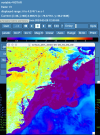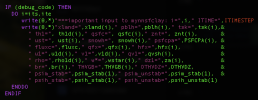pareja
New member
Hello all,
I am working with the "gustiness" or free convection velocity scale (w*) over water based on Beljaars (1995) for the MYNN surface layer scheme. I wondered what temperature should go in the buoyancy parameter g/T in this scaling, for model coupling purposes.
Paper: https://rmets.onlinelibrary.wiley.com/doi/epdf/10.1002/qj.49712152203
Code: WRF/phys/module_sf_mynn.F at master · wrf-model/WRF
The Beljaars definition for WSTAR (equation 8) includes the buoyancy parameter g/T. Since this scaling comes from the buoyancy production term in the TKE budget, I assume T here would be a surface air temperature (e.g. T2 or T at level 1). However, I see that TSK (skin temperature?) is used:
The Olson et al 2012 technical memorandum on MYNN surface layer (https://doi.org/10.25923/f6a8-bc75) suggests the temperature would be the potential temperature at level 1 (theta_1) for w*.
I wondered: Is TSK here a skin surface temperature (level 0) or an air temperature (level 1)? Would this make a difference in the value of w*? I will be working in very low mean wind conditions where free convection drives the surface heat fluxes.
For context: we are working on coupling an ocean model (ROMS) with WRF. When coupled, ROMS computes bulk fluxes, including w* (gustiness), based on the WRF air temperature at 2m (T2). The snippet below is from ROMS for gustiness (slightly modified for clarity)
Thanks,
Fernando Pareja-Roman
Rutgers University
I am working with the "gustiness" or free convection velocity scale (w*) over water based on Beljaars (1995) for the MYNN surface layer scheme. I wondered what temperature should go in the buoyancy parameter g/T in this scaling, for model coupling purposes.
Paper: https://rmets.onlinelibrary.wiley.com/doi/epdf/10.1002/qj.49712152203
Code: WRF/phys/module_sf_mynn.F at master · wrf-model/WRF
The Beljaars definition for WSTAR (equation 8) includes the buoyancy parameter g/T. Since this scaling comes from the buoyancy production term in the TKE budget, I assume T here would be a surface air temperature (e.g. T2 or T at level 1). However, I see that TSK (skin temperature?) is used:
Code:
!--------------------------------------------------------
! Calculate the convective velocity scale (WSTAR) and
! subgrid-scale velocity (VSGD) following Beljaars (1995, QJRMS)
! and Mahrt and Sun (1995, MWR), respectively
!-------------------------------------------------------
! Use Beljaars over land and water
fluxc = max(hfx(i)/RHO1D(i)/cp &
& + ep1*THVGB(I)*qfx(i)/RHO1D(i),0.)
!WSTAR(I) = vconvc*(g/TSK(i)*pblh(i)*fluxc)**.33
IF (xland(i).gt.1.5 .or. QSFC(i).le.0.0) THEN !WATER
WSTAR(I) = vconvc*(g/TSK(i)*pblh(i)*fluxc)**.33
ELSE !LAND
!increase height scale, assuming that the non-local transoport
!from the mass-flux (plume) mixing exceedsd the PBLH.
WSTAR(I) = vconvc*(g/TSK(i)*MIN(1.5*pblh(i),4000.)*fluxc)**.33
ENDIFThe Olson et al 2012 technical memorandum on MYNN surface layer (https://doi.org/10.25923/f6a8-bc75) suggests the temperature would be the potential temperature at level 1 (theta_1) for w*.
I wondered: Is TSK here a skin surface temperature (level 0) or an air temperature (level 1)? Would this make a difference in the value of w*? I will be working in very low mean wind conditions where free convection drives the surface heat fluxes.
For context: we are working on coupling an ocean model (ROMS) with WRF. When coupled, ROMS computes bulk fluxes, including w* (gustiness), based on the WRF air temperature at 2m (T2). The snippet below is from ROMS for gustiness (slightly modified for clarity)
Code:
!
! Compute gustiness in wind speed.
!
Bf=-g/TairK *Ustar *(Tstar +0.61 * TairK * Qstar)
IF (Bf.gt.0.0_r8) THEN
Wgus = beta*(Bf*PBLh)^1/3
ENDThanks,
Fernando Pareja-Roman
Rutgers University


